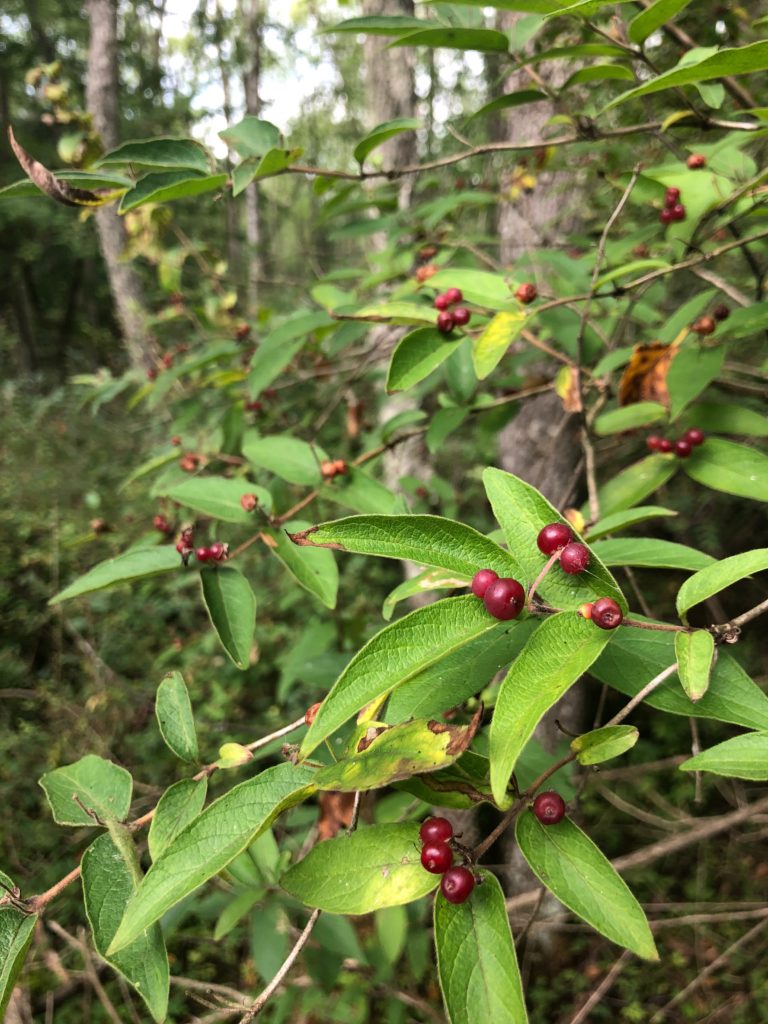Written by Jenna Brandl, summer intern for Woodland Dunes
Honeysuckle, horrendous? I wouldn’t have believed it a month ago either. As a Woodland Dunes Land Management intern I often interact with honeysuckle. The Tartarian and Bush honeysuckle, aka Lonicera sibirica tatarica and Lonicera sibirica latifolia, are two of the most common subspecies found in Wisconsin. These shrubs can range from three to fifteen feet tall which can make them look more like a tree than a shrub.
How you can identify honeysuckle: look to see if the leaves are 1-2 ½ inches long with an oval shape at the stem that leads to  an abrupt pointed end. Their stems and branches are: grayish brown, have broad grooves, and are thornless. May through June, these shrubs produce white or pink flowers that start to yellow as they age. In September and October, they produce red juicy berries in groups that usually occur at the leaf axil (where the leaf meets the twig). These elegant flowers are what some may say “easy on the eyes,” so why are these intricate shrubs so dangerous to our delicate ecosystems?
an abrupt pointed end. Their stems and branches are: grayish brown, have broad grooves, and are thornless. May through June, these shrubs produce white or pink flowers that start to yellow as they age. In September and October, they produce red juicy berries in groups that usually occur at the leaf axil (where the leaf meets the twig). These elegant flowers are what some may say “easy on the eyes,” so why are these intricate shrubs so dangerous to our delicate ecosystems?
Surprisingly, they are actually an invasive species that cover a broad range of habitats including roadsides, lakeshores, open woods, forest edges, and old fields. Countless people continue to plant these invasive shrubs, especially the Eurasian Bush honeysuckle, as ornamentals in their yards that lead to the spread. Birds are no help either. By eating the berries and flying from place to place, numerous species of birds spread honeysuckle twice as quickly. This makes the process of controlling their spread extremely difficult and why we typically find these plants at the bottom of trees that birds perch in.
Honeysuckle is also hazardous for plants such as tree seedlings and wildflowers because they are known to alter the habitat around them by decreasing light sources, soil moisture, and nutrients. According to the Wisconsin DNR, it is also possible that L. tatarica releases allelopathic chemicals that prevent the growth of other plants around them. Does this affect the growth of trees as well? Hopefully, new research might arise to help solve this mystery alongside my own investigation at the Woodland Dunes Preserve.
It might leave you flabbergasted to learn that honeysuckle is not your typical plant but an invasive to our wetlands, temperate forests, and prairie ecosystems in Wisconsin. Now you may be wondering, “How do I control this invasive plant?” The best way is the process of cutting the shrub stems and applying a herbicide treatment. It may be a tedious task to cut down the entire shrub, but it is the most effective way to kill the honeysuckle due to its multiple stems and large growth radius. In order for this treatment to be successful, all stems must be cut and treated with herbicide so no new growth is allowed to occur. After a month of combating these hellish shrubs, it’s my hope that others will begin to recognize and take steps to prevent the spread of honeysuckle.
photo: honeysuckle in berrying stage by Jenna Brandl
